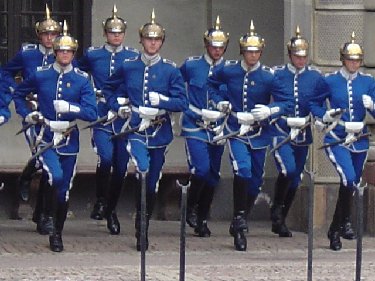|
|
Paul & Dianne Postcard From Europe |
|
Sweden
We arrived in Gothenburg in Sweden on the high speed ferry from Frederickshavn in Denmark. A swift two hour trip where the main activity for everyone on board is changing money and getting rid of Danish coins.
Gothenburg is Sweden's second largest city, and from there we bussed across to the capital, Stockholmn. Stockholmn is located on many islands within the Stockholmn archipeligo which has 20,000 islands, about half of which are inhabited. Just about everyone in Stockholmn either owns or rents a summer house on one of these islands during the summer . Given that it is summer now this makes the city pretty empty as all the locals are on their summer holidays, out of town.
The old town, Gamla Stan, is a maze of narrow laneways and tall coloured limewashed buildings, with little squares at many of the intersections. Fantastic to just wander the cobbled streets and take in the atmosphere, or sit at one of the many cafes.
We visited the Vasa Warship which sunk in the 1600s after a 1000 metre maiden voyage, which ended in its falling over and sinking. It was raised from the bottom of Stockholmn harbour in 1961 and is the only intact 17th century boat in the world. It was basically refloated intact and is huge. At 69 metres long it was very large for those times and was intended as a troop ship. Obviously not very well designed, but the restoration is magnificent.
We took a boat trip out to the archipeligo for dinner to a lakeside restuarant on a farm. It was a glorious evening, daylight until after 9 pm. Most of us had reindeer for the main course - eaten rare it was delicious, and not at all politically incorrect in this part of the world. No sign of Rudolph at all!
The changing of the guard at the Royal Palace in old Stockholm was very interesting. Instead of the usual marching and shouting etc. here the guards actually ran full bore as they changed guard. Lots of action as well as colour
The countryside is so picturesque. Everywhere there is green grass, rolling hills, small villages - all with red and white timber cottages and barns. The red-brown colour is just about universal throughout the countryside in Sweden. The colour comes from the copper in the paint which preserves the timber and comes from the the 1000 year old copper mine in Falun. This mine provided copper for the whole of Europe.
Our parting memories of Sweden as we headed west and started to climb the mountains into Norway were the forests. Birch, Spruce and Pine - all straight as an arrow and all very tall, crowded together, mile after mile. No wonder all the buildings are made out of timber. Moose territory, but unfortunately we didn`t catch any glimpses.
|





